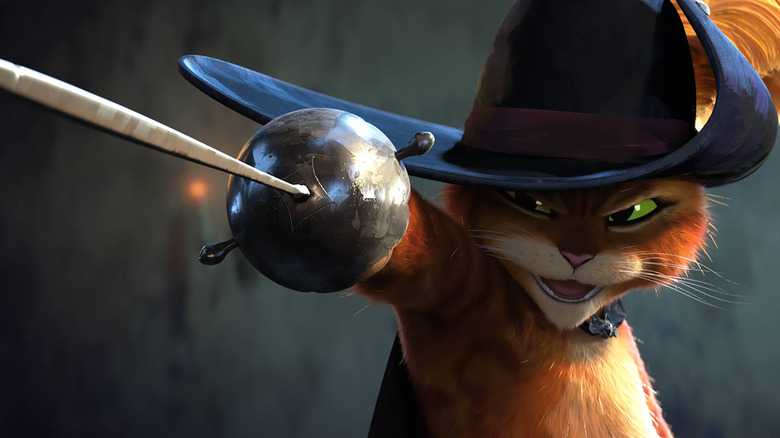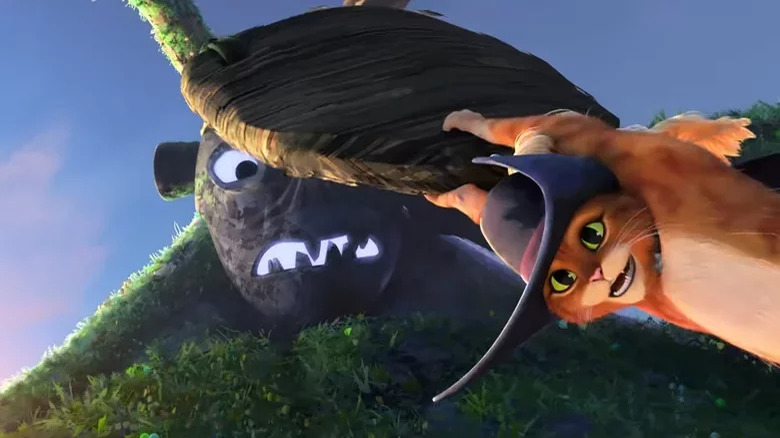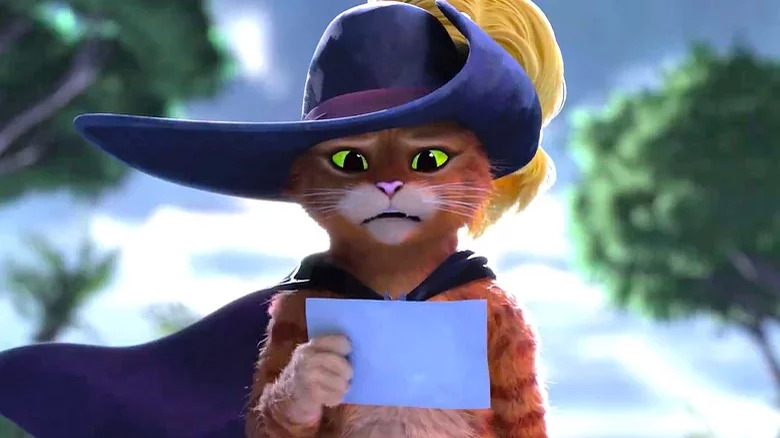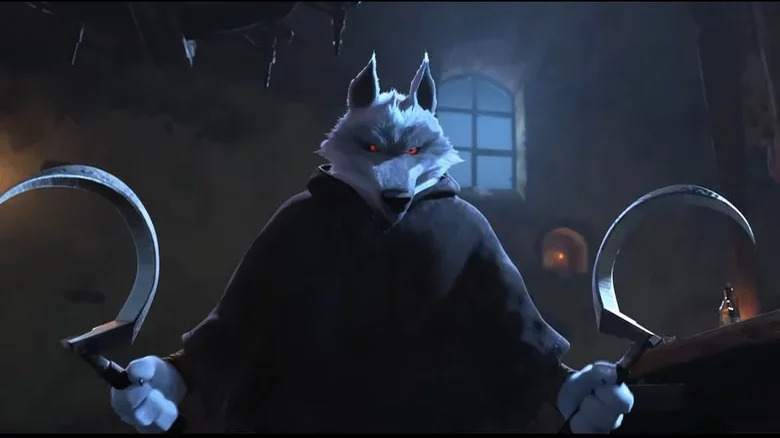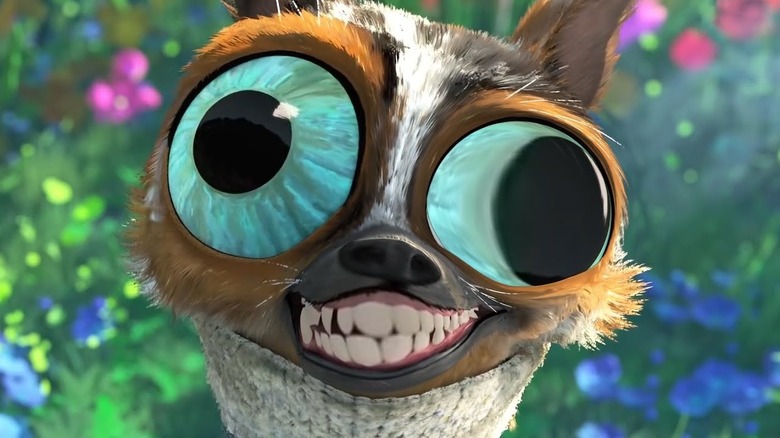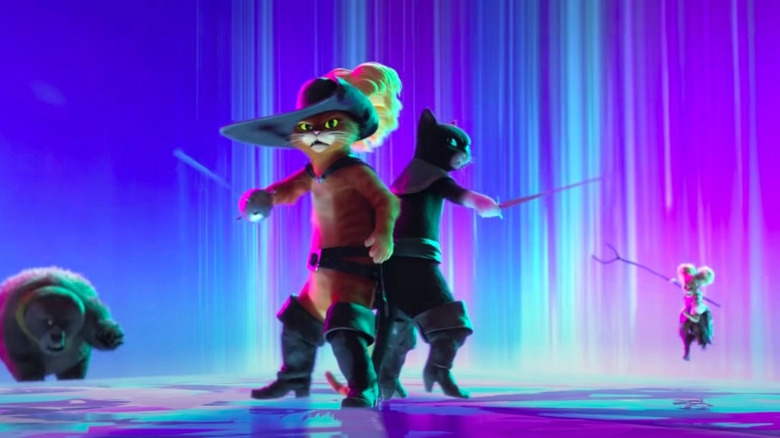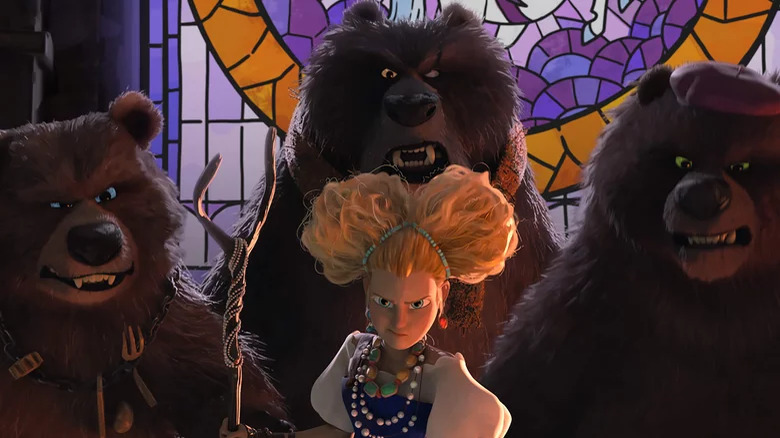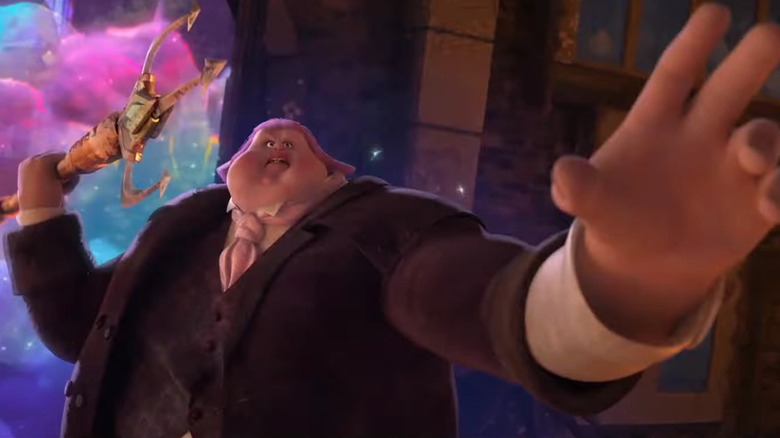Puss In Boots: The Last Wish Director Joel Crawford On Making A Darker Movie In The Shrek Universe [Exclusive Interview]
At the beginning of 2022, who would have thought that a sequel to an 11-year-old film, the sixth entry in a 21-year-old franchise, would end up being one of the best animated movies of the year? But that's only part of what's surprising about "Puss in Boots: The Last Wish."
Antonio Banderas returns as the titular Puss, who discovers he's down to the last of his nine lives, having lost his other ones by acting recklessly. Depressed and scared for the first time, he embarks on one last desperate quest — to find a legendary Wishing Star, which could grant him more lives and allow him to return to his devil-may-care persona. The film looks stunning, with stylized visuals that mix 3D and 2D, anime-like fight scenes, and a darker story inspired by spaghetti westerns that's reminiscent of something like "Logan."
With the film now in wide release, /Film got the chance to talk to the director of the film, Joel Crawford, about reinventing the character, making the action feel more like anime, playing with fairytale characters, and more.
Note: This interview has been lightly edited for clarity and brevity.
Building on what came before
This film has been in development for a while. How did you get involved?
[This movie] is an interesting one, where the studio has been wanting to make it since the last "Puss in Boots" over a decade ago. To their credit, DreamWorks was not just going to make another one without it being the right big next chapter, but that did mean it went through a lot of development — a lot of really talented different filmmakers and writers would come in and take passes at the project.
I came onto it after I had wrapped up on "Croods: A New Age." Having just come off of that and had a great time dealing with an ensemble cast, and comedy, and then heart underneath it all, I was excited to tell more stories that had a lot of great rich characters that could take us on a journey. The idea that Puss was on his last life was just so interesting to me. That's something that existed. We've really benefited from hindsight, in a way, of getting to build on a lot of great story ground that's been broken over the years.
What I love about animation is it's so collaborative. When you're working on a movie, you're really pulling the best ideas of your crew. In this case, we weren't just pulling the best ideas from the present, we're also building on the past. I think that really benefited us to go, "There's something so special in this idea that the absurdity of a cat being on its last life in 'Puss in Boots,' but then the reality that it's about someone realizing life isn't forever," and taking on this idea of mortality.
When I came to it, I was like, "This movie has the potential to start out as this absurd, fantastical fairytale, and then be this poignant message about celebrating life." That just excited me, that challenge.
A grounded absurdist tale
What was it that you wanted to bring into the project? What was the key that for you was like, "Oh yeah, this is where I want to take this now"?
Like I mentioned, you have the benefit of hindsight when there's been multiple talented people trying to crack this. I think one of the things that I felt like the project really needed was to be grounded in tangible stakes, because it is so absurd. You have a combination of a fairytale idea, this myth of nine lives, and you have a character in Puss in Boots that is so cavalier with his appreciation for those lives, that if you don't have real stakes, the movie's never weighted. It always just feels like it's a fun premise, but we really needed the audience and Puss in Boots to believe, "Oh, I could die."
That was actually an interesting kind of discovery. We knew we needed to get there, but the how was a journey. It's so fun to kick off the movie as a comedy, there's music in the beginning, it's fun, there's energy, Puss in Boots is taking on a giant, it's fantastical. As an audience, everything is so choreographed that you feel like you're in good hands. You don't feel fear, neither does Puss in Boots. You're on this rollercoaster that's attached to Puss's emotional state.
It was like, let's just come in on big, fun energy, and be right there with Puss' worldview of "I'm going to live forever, this is great." The party keeps going, and then even when it gets crushed by the bell at the end of that opening sequence, even his cavalier point of view stays. The doctor's office, when he gets delivered this information about "You're on your last life," and Puss is recalling the past lives, we found, and James Ryan, the editor, he quickly put in this music that just made it so fun to relive each of those lives, and Puss is not really taking those lives seriously. They were all kind of thrown away because of his comedic ego.
[It was] really kind of priming the audience for this big turn that comes when the wolf shows up. We found we had to make this a moment where not just Puss's fur on his arm stands up, but also maybe the hair on the audience's arm stands up. You go, "Whoa, this is not what I expected. Where is this going to go?" I think you need that reality to jolt you to believe and to go on the ride of this story. That was the big nugget that we, as a team, brought into this.
'We didn't want to bring anything down to the youngest age'
How do you go about finding the right tone for that scene, where it doesn't go too far in terms of intensity, but still showing more than what we've seen so far?
These movies are kind of like sculpting. You're always adding or taking away and you're just trying to find what feels right. And really, with that one, I approach most things as a comedy because I just love character comedy, but that's my endpoint. For me, it was kind of a discovery of, "This has to be scarier. I'm not feeling anything here."
We kept going further until we found kind of two key ingredients. Puss is bragging about how he's never been touched by a blade in his opening song. This is kind of the epitome of his arrogant, immortal worldview. To be able to find a way to bring that back in a very poignant way felt like, "Well, Puss has to bleed here." When you're working on a DreamWorks movie, you're going, "I don't think we've had blood in previous installments of any of these movies," but that was just one of those things where we're always cognizant of not being literal but impressionistic. If we're going to go somewhere, it's the feeling, but it's really just a drop of blood that you see.
Nate Wragg, the production designer, found this great thing where, by the moment we do this kind of freeze-frame in the air where the Wolf swipes at [Puss], and the whole background goes red. As an audience, you get this wash of red. Then the very next shot is this kind of Sergio Leone closeup of Puss's eyes and the only red in the shot is a drop of blood. That makes the audience impressionistically, they feel the red, and then they zero in on the very next shot, just that coming down.
That felt like it did the thing where we wanted that to be a huge deal, but it's still something that's completely appropriate for children, but also accessible for the oldest of the audience. I think that was a big thing for us on this. We didn't want to bring anything down to the youngest age. We wanted to bring everybody up to this elevated storytelling, where we could make sophisticated choices, but be aware that it's still for everybody.
I think the other thing that helps is it's still a comedy action adventure. You have these spikes of fear, but you're not living in that, really, for a long time.
'Let him be the sunshine amongst the clouds'
Speaking of the comedy, I love Perrito. I'm curious about how you guys figured out that character and his intersecting with Puss's story in the film.
There's these different kind of angles where we knew the template was "The Good, the Bad, and the Ugly." You've got all these kind of larger-than-life, cynical characters going after this treasure. In this case, you've got them going after this ultimate fairytale prize of one wish. We knew we had all these characters, but we needed a device to carry the theme of the story that everybody who's selfishly after this thing they think will fix their lives.
We're like, "That'd be amazing to introduce a character who wants nothing, who just wants to share moments and have friends and appreciate what's around him." That was kind of the catalyst, story-wise. Then one of the fun traits of finding that character, the co-director Januel [Mercado] and I were looking at the Man With No Name, and just thought it's fun to have a subtle reference of a dog with no name. But it's because he's never had a home, never had anyone to name him.
There's another geeky inspiration, which was, being Akira Kurosawa fans, the "Seven Samurai," Toshiro Mifune plays this samurai that's kind of the wild card, where he's not really respected by the other samurai in the beginning of it, but he kind of carries the heart and inspires everybody. We're like, "That'd be great for this dog to be like that." He's kind of disregarded at the beginning. He's actually annoying to Puss and even Kitty, and they don't trust him. Then he carries this warmth with him.
I think that's kind of the magic that Harvey Guillén found in Perrito. The other ingredient is Harvey, where Harvey just has this unstoppable optimism as a person. He brings that humanity into the character. It just was perfect casting to have Harvey take this character, in a way that comedy comes from the fact that you don't expect this character to be in this movie. He's the only character who's not badass and selfish and quippy. He's just so pure and innocent. We found all we had to do was let him be himself, let him be the sunshine amongst the clouds, and you will laugh at the contrast. I love comedy that comes from that kind of character. It's not jokes, it's the dynamic that you're just really enjoying.
Putting us inside the fights
The final fight really reminded me of "The Good, the Bad, and the Ugly." Can you talk about crafting that scene, particularly the action?
I love action and comedy. I feel like it's so important to have a message and to have so much heart underneath stories. For me, I want audiences to watch the movie because the entertainment grabs them. I think it is the device, almost the sugar that you need to make the medicine go down. They come to this expecting the comedy, the action, the adventure, and we wanted to deliver on that, but we wanted to have a story concept behind the stylization of it.
We used the traditional smooth animation, of CG, in contrast with what we call stepped animation, which kind of hearkens back to more traditional hand-drawn and also anime. You get a different feel with the two. Our philosophy was, let's tie this different stylization to Puss's worldview and let the audience experience it. There's these fantastical action scenes. The opening giant fight is a stepped animation. The reason stepped animation has this feel is because you're holding a drawing for, say, two frames instead of one frame.
So, you have this effect of, let's say you'd have 12 drawings for a second versus 24 images. It's less smooth, it's less grounded in reality, but it feels fantastical. Your eye gets to pick up some extreme poses. When you're watching Puss fight this giant and it feels like it's so pushed and hyper-fantastical that you're just enjoying it. You don't feel like, "Oh, he's going to die," and he doesn't feel that way. Then to be able to contrast that with moments like in the doctor's office where you're getting very important reality delivered, and it's all fluid CG, everything's on ones. You're using it as moments to — it's a debate of life, this fantasy of "I'm going to live forever," versus slowing down and appreciating every moment. For moments of vulnerability, we would use traditional CG.
Then beyond that concept, we did just have so much fun with the action. Chris Stover, the head of layout, he did an amazing job with his team of putting us inside the fights. You're feeling it, you're right there with Puss. Even later, when he's aware of his mortality and the jeopardy is high, but in some way, it's just so exciting and fun to watch. That was just such a fun opportunity in this, because we've extended our toolset. We're not just making everything like CG animation, but we're mixing these styles.
The Good, the Bad, and the Goldie
How did you find a balance of, this is still taking place in the "Shrek" fairytale world, where you can use anything you want, but not take anything away from Puss's story?
The "Shrek" world is so fun with all of the characters you could pull in. It was very important to us to keep the story about Puss in Boots. Going back to this "The Good, the Bad, and the Ugly" as a template, that helped guide us to which characters are essential. To break it down, you got the good, being Puss in Boots, you got Kitty Soft Paws and Perrito all joined. The bad, the hilariously bad Jack Horner, voiced by John Mulaney, who was so fun.
Then we called it "The Good, the Bad, and the Goldie," because we got Goldilocks and the Three Bears, they're antagonists to what Puss wants, but they're kind of misunderstood. There's a fun edge to this crime family, but they're still a family, so there's a surprising warmth. That was our template to go, "We can have all these characters who are after this, but that's how we're going to organize it so it doesn't get turned to chaos."
Then with any kind of, say, cameos from the "Shrek" fairytale world, we were very cautious, even though we love them, we had to make sure there was a little story reason for them. Puss in Boots by all rights deserves his own stories. You wanted to make sure you weren't doing anything that distracted from this huge story of him understanding what one life can be if lived well. It is definitely a balance. Then of course, introducing the Wolf, like I was mentioning, felt necessary. It's so personal with Puss, and that's really his debate about mortality.
That one, even we'd reference other kinds of westerns like "Butch Cassidy and the Sundance Kid," where you got that Pinkerton gang — every time you looked on the horizon, they're right there. They're always just there. That kind of fits still within the spaghetti western world. Not to pull too many random references, it was always either the fairytale "Shrek" world or the spaghetti western world, and making sure those all kind of led up to the end theme.
'This is an animated movie, but we're not treating them like cartoons'
Were there any other characters that you considered before you landed on the ones in the movie, like Goldie and the Bears, or the Wolf? Were there others that you thought of for the movie before landing on those?
There were some. We definitely went through a good amount of naming different, "Oh, could it be this character, this character?" But when we found the ones we did, it just felt so right that those stick with me where I'm like, "I washed my mind of the other ones." What was fun was also still the challenge of finding the voice, both literally the voice casting, but also in the "Shrek" world, it's like you see a fairytale character you've heard of, but their personality is the surprise of what those quirks are, what the specificity is.
Really, that was the journey of finding — Mark Swift, the producer, was one who, with Goldilocks and the three bears, Mark being from England, was like, "I feel like they have to have this Guy Ritchie edge and this cockney, kind of rough-around-the-edges feel to them." That just felt right. We were like, "Yes."
Then even with Jack Horner, what was fun with that was when you're thinking about fairytale characters, you go to all the well-known ones. Then Paul Fisher, the writer was like, "Guys, it's hilarious. Can you even say the Jack Horner rhyme?" We couldn't. We were like, "Little Jack Horner sat in a corner eating his curds — no, that's a different one." To build a character's worldview off of that, that it's the most forgettable, not even a fairytale character, but a nursery rhyme. We formed this whole kind of point of view of this guy who wants power, he wants to be important. He spent his life acquiring magic. And of course, this one wish to him means all the magic in the world. It's so misguided, but you understand where it comes from.
I think for us, we wanted to make sure there's a sophistication. That in a way, these characters, this is an animated movie, but we're not treating them like cartoons. They are well-developed, well-rounded characters that we've put all this thought into. You really get this experience where you feel you're in this world with Puss in Boots, and we've really kind of built out this world. That was our goal.
"Puss in Boots: The Last Wish" is in theaters now.
